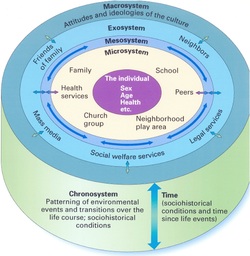Essential Questions: Focus is on Cognitive, Social, Behavioral and Constructivist Theory.
- How does socioeconomic status affect achievement, and identify ways schools can help children from low-income families succeed?
- How does race, ethnicity, and language differences affect students' school experiences, and identify important principles for teaching in culturally diverse schools?
- How does gender bias impact schooling, and identify ways to support all students with equality and respect?
- What are common definitions of and theories about intelligence and learning styles and how student diversity inform intentional teaching?
Goal: is for students to make connections/seek out interrelations, to theory, based on one or more of the topics touched on during this weeks class topics.
Objective:
- Through the interconnection of current scholarly journals, related articles and or research, graduate candidates will write an annotated bibliography associated to student diversity which will make connections to their literature review.
Warm-Up Activity: Think-Pair and Share
"Children in our schools are a mirror of society. This diversity will also be found in your students along a number of dimensions".
- What does this mean to you?
- What diversity is being directed?
Dimension of Student Diversity or Exceptionalities: Arends (2015) provides a look at student exceptionalities. He informs of he some of the greatest diversity found in today’s classrooms. He states “in any one classroom, teachers find students with severe learning, disabilities or other special needs as well as students who are gifted and possess special talents”.
In review of InTASC Standard 2, Learning Differences, and Slavin (2018) in citation of Banks, individual identity consist of:
Exceptionalities Include:
- Students with Disabilities
- Gifted and Talented Students
- Culture, Ethnicity, and Race
- Religious Diversity
- Language Diversity
- Gender Differences
- Social Class Differences and Poverty (p. 55)
- Race
- Ethnic Group What is the difference between race and ethnicity?
- Disabled or non-disabled group
- Religion
- Region
- Gender
- Social Class (p. 66)
Student Activity 1: Group Work
- From the theories studied so far: Cognitive, Social, Behavioral, and Constructivism, what connections can you make? Create a statement with a stance for each theory.
Student Activity 2: Complete these surveys
Do you stereotype?
Topic 2: How does race, ethnicity, and language differences affect students' school experiences, and identify important principles for teaching in culturally diverse schools?
Student Activity: In what ways does the Social Capital and The Achievement Gap affect students' school experiences?
Topic 2: How does race, ethnicity, and language differences affect students' school experiences, and identify important principles for teaching in culturally diverse schools?
Student Activity: In what ways does the Social Capital and The Achievement Gap affect students' school experiences?
- Read and Preview: Social Capital and The Achievement Gap what comparisons are there related to the SDDOE Report Card
- Finish up by viewing this video
- What connections can be made to Bronfenbrenner's Bioecological Theory?

Topic 3: How does gender bias impact schooling, and identify ways to support all students with equality and respect?
All Teachers Should Be Trained To Overcome Their Hidden Biases.
Topic 4: How do students differ in intelligence and learning styles?
- View this link: Howard Gardner and Multiple Intelligences https://www.youtube.com/watch?v=iYgO8jZTFuQ
Assignment (Due Next Week): Rational - What are common definitions of and theories about intelligence and learning styles and how student diversity inform intentional teaching? Basically to make connections to the theories studied to finalize the literature review.
- Read Chapter 4: Student Diversity
- Seek out extended scholarly literature related to student diversity, apply to an annotated bibliography to later be used in your literature review.
- Early Child Development: A Conceptual Model
- What is Diverse Pedagogy?
- Implications of Socioeconomic Status on Academic Competence:A Perspective for Teachers
- ON THE ORIGINS OF GENDER HUMAN CAPITAL GAPS:SHORT AND LONG TERM CONSEQUENCES OF TEACHERS’ STEREOTYPICAL BIASES


No comments:
Post a Comment